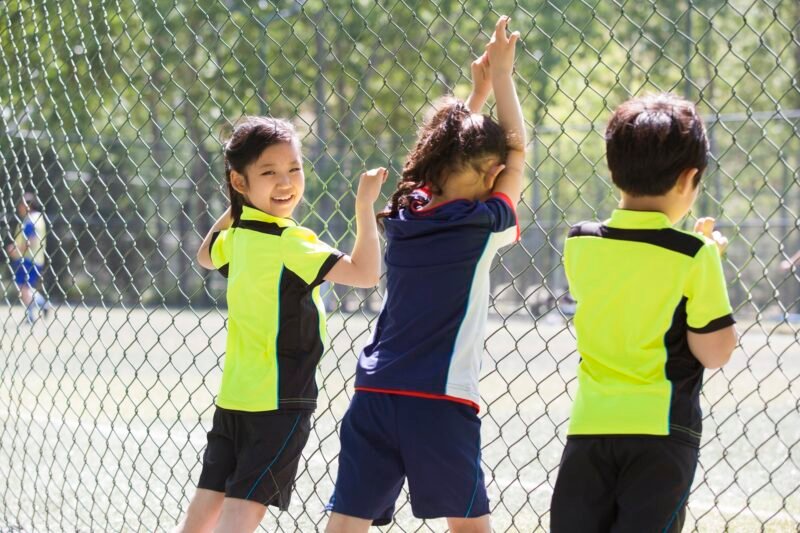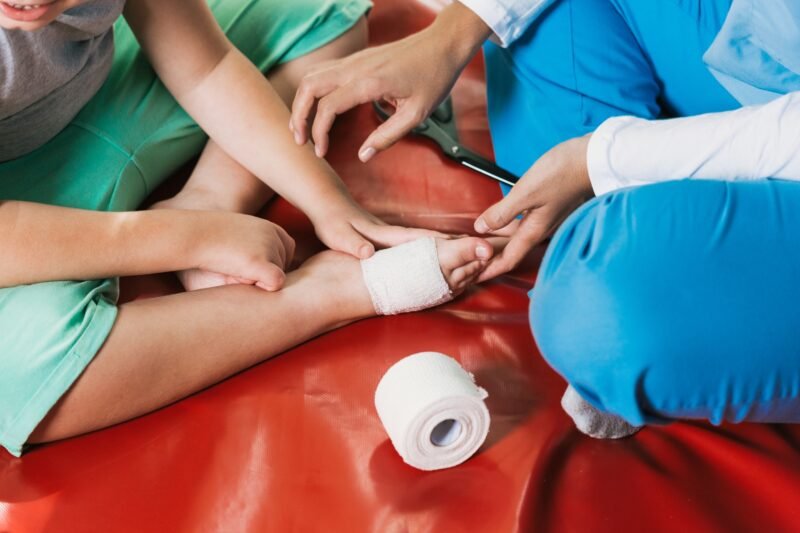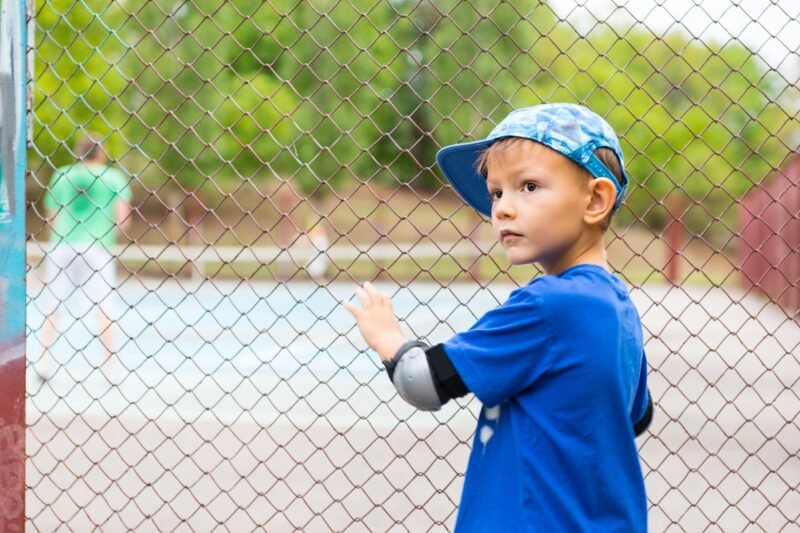Pickleball for Kids: How to Get Children Playing Safely & Confidently
Prefer to listen? Tap play below!
Pickleball for Kids: A Fun Guide to Getting Started
Pickleball is a popular sport played everywhere (elementary schools, parks, and community centers). It’s a perfect combination sport, combining parts of tennis, badminton, and ping-pong, and easy for people of all walks of life to pick up. Pickleball has a smaller court size and slower-paced gameplay than other similar ball and paddle sports, and is a great game for kids to play.
In terms of social development skills, like conversational competency and reciprocity, pickleball can be a great way for kids to get these skillsets. In pickleball, the game is played like singles (two-player format) or like doubles (four-player format). Overall, the rules for pickleball are easy to remember and easy for kids to pick up on.

There are more and less expensive options within the marketplace for paddles. Some paddles go into the hundreds of dollars. The alternatives are dependent on the current age/skill of the child. Pickleball’s score is counted to 11 with a team up by 2 to win.
Basic hitting or serving can take a bit of practice. Parents don’t need to start their kid off by making sure they have proper form. Let them try and figure it out for themselves for a little bit; you’d be surprised what they can do themselves (even the really little ones get the hang of it).
Understanding Pickleball
One of the most compelling aspects of pickleball is its appeal to children. The simplicity of the game, requiring minimal equipment and space, makes it accessible to kids from various backgrounds. All that is needed is a paddle, ball, and a net, allowing children to play in parks. This accessibility encourages participation and fosters a love for the game from an early age, promoting physical activity and teamwork.
Moreover, pickleball teaches valuable life skills. As children learn to work together to achieve a common goal, they develop communication, cooperation, and leadership abilities. The sport also instills a sense of discipline and resilience, as young players face challenges on the court, learning to cope with both victories and defeats. These lessons extend beyond the game, shaping character and social skills that are essential in everyday life.
The global nature of pickleball further enhances its appeal to kids. With international stars and local heroes, children are inspired by the stories of players who have risen from humble beginnings to achieve greatness. This aspirational aspect of the sport encourages kids to dream big and work hard, reinforcing the idea that dedication and passion can lead to success.
In conclusion, pickleball, combined with its accessibility and life lessons, make it an ideal sport for children. As the game continues to grow and adapt, it remains a powerful tool for fostering community, promoting physical health, and teaching essential life skills, ensuring its place in the hearts of young players around the world.
Essential Pickleball Equipment for Kids
Right equipment = enjoyment + performance. The three primary pieces of pickleball equipment you’ll need to get started are paddles, balls, and nets. As for paddles, they can significantly affect how you play because they come in various materials, weights, and sizes. When starting, get a paddle that is lightweight and has an oversized sweet spot. This will enhance the kid’s control and mitigate the chances for a possible injury on their elbow (what we call a “pickleball elbow”).

Medical professional applying bandage to injured foot of young patient during physiotherapy session, providing essential wound care and first aid
What ball you play with is equally as important. Pickleball balls are typically constructed from plastic and there are two kinds: indoor and outdoor. Indoor balls are a bit lighter, have larger holes, and are better suited for the conditions you face indoors where the playing surface is smooth and there is no wind. As a result, beginners should get a ball that best matches the environment they expect to play in so that the conditions they play under are somewhat controlled.
Another critical element of pickleball equipment is the nets you play with. Standard pickleball net dimensions are 36 inches high at the sidelines and 34 inches high at the center, which is where the dimensions of the court come into play. Much like those aforementioned portable sets, having the ability to slam a pickleball net down on your driveway or at the park on a summer day is a game-changer. Investing in a high-quality net that is easy to set up will get children playing and ultimately practicing more often.
However, when I mention “age-appropriate and size-appropriate gear,” your physical stature, strength, and comfort handling the equipment influences what gear is best suited for you. For example, if you are shopping for a child, getting them a paddle that is smaller in size and easier to handle will speed up their learning experience and perhaps give them the confidence they need as it will be easier to handle. Conversely, finding the right gear is, of course, important for adults too. Most people probably prefer a paddle that offers great control while others will probably want something tailored to power.
In conclusion, finding the right pickleball technical gear will make the learning/teaching experience so much more enjoyable.
Learning the Rules of Pickleball
Pickleball is a fast-growing sport that brings elements of tennis, badminton, and ping pong together. The basic rules of pickleball are all that you need to know to get started. The court is similar to a badminton court, and the net is similar to a tennis net but slightly lower. The server (you can play singles or doubles) hits the ball diagonally across the court. And, you win the point by hitting the ball across to your opponent’s side so that it cannot be returned, including getting your serve in, all according to the various rules like the double bounce rule and the kitchen, or non-volley zone rule.
Fun Pickleball Drills for Kids
Pickleball has found a wide audience because it’s great fun and easy to play. Although it’s a quick game to pick up, there are certain skills you absolutely have to learn if you’re to progress at a decent rate.
And what’s the best way to master these skills? Basic drills. The ‘basic’ in basic pickleball drills refers to the main strokes, or mechanics, you’ll be using. Here are four areas to think about.
Serving (underhand)
This is the No. 1 basic pickleball drill. You and a friend go onto a court with a box of balls each. Spend time serving at targets. Go for the backhand and forehand receivers’ court, and hit your targets from different positions on the service line.
Then try hitting to the forehand side with backspin. Maybe add a bit of side-spin so the trajectory of the ball stays the same, but the contact and rebound are different. Finally, try a more compact swing. Stand tall and keep a stable balance.
Volley
Again, this is a real basic pickleball skill. Played in the air, the volley is a quick attack and requires a more compact swing. Stand totally still with your feet on the ground and about shoulders’ width apart. Keep your arms away from the body. Watch as your opponent hits the ball to you and time your shot. Contact the ball with your arm prepared and in the center.
Knowing where to place the volley is key to your game. Play it with speed and the point will be over within three or four shots. Play it slowly and your opposition may find enough time to react to your volley and respond with their own well placed shot.
Smash
This third basic drill is all about knowing when to play a smash and knowing when a smash is likely to happen. The smash is a quick attack. You play it in the air.
So first, practice moving forward. Then, play your contact shot with your arms away from the body. Start the shot with your arms totally straight. The first movement of your hand should go toward the ball. After contact, push the paddle away from your body.
Return of service
Some players prepare for the return of service shot by moving backward and opening out their shoulders. This creates a lot of space. Other players create space by stepping out of the line of the shot as the ball is heading towards the other side of the court.
When basic drills are difficult to remember, use patterns. Teach yourself a simple pattern for forehand movement and a simple pattern for backhand movement. Lots of practice will improve this movement on your muscle memory. Then, you don’t have to think about the pattern of movement, just the direction and rhythm of your shot.
By the way, you’ll obviously learn a lot by watching other players play the game. Pickleball is enjoyable, yes, but it’s also an excellent way for children to learn how to think strategically. If a child develops an understanding of basic pickleball strategies, their game, and their fun, will improve immeasurably.
One of the main factors that beginning players should learn to consider in their strategic mindset is where they are “on the court” relative to their opponents and ball. When a player is serving or being served the ball, a position close to the net gives an advantage. This will also encourage the player to develop the skill of “finessing” where the ball will go as well as build mental acuity for judging distances (more judgment will be required for determining where the fast-moving served ball will land “in bounds”).
The other main skill set beginning players will need to develop is anticipating, remembering and understanding different styles of play. This will help the young adults develop or enhance communication skills (“You moved that way, so I moved this way”) and appreciation for the physical or mental skills of the opponents. An introverted person may develop “outgoing” social skills this way, or conversely, a “hypercompetitive” athlete may develop appreciation for another person’s “love of playing the game well, rather than winning at all costs” attitude.
Hopefully, this writing encourages you to help children and young adults improve their thinking skills by improving their enjoyable Pickleball game.
Getting Started with Pickleball
Finding local pickleball programs or clubs for kids can be an exciting journey. Look for places like:
- Community centers
- Schools (especially for middle school level or younger)
- Local rec centers (many even have designated youth nights)
- The USA Pickleball website
- Apps or websites that cater to your local city places of interests (many cities have a sports players association or something similar)
- Facebook, Instagram, or even ol’ reliable Reddit and similar forums
Consider popping into clubs that are a “maybe” for the list to see how the coach interacts with the students, the ratio of kids to coach, or if the atmosphere just seems like a good time or not. If you’re lucky, you might just be able to slot in for that class you’re observing (many places offer a first class free, so be sure to ask).

A local tournament scene where families to get in on the action just might be a fun way to switch up a traditional weekend. Even if said tournament is for 19+ players, the kids might get a kick out of watching everyone play or take in other events that are on (pickleball isn’t a sport that’s on TV often so this may be one way to get it in their memory).
Whether you lose or win, it’s all in the name of fun anyway. Good times, food, or other small-scale events will likely be happening at the same time. Considering this point, it could very well be the extra push needed to gain an interest in the sport. I also must say it’s neat for the next generation to see or observe the interaction of large groups of people (many PB scenes are very inviting and easy to chat with).
You’re out at the park or beach with kids? Bring the pickleball set along! Pickleball is quickly starting to become the kids’ sports pick of the moment and it’s no wonder: it’s easy, it’s loads of fun, it’s super engaging, and getting the basics right doesn’t take more than a handful of attempts, which is definitely part of its appeal.
Some of the basic things you might want to explain are:
- The importance of children’s sports equipment. Try to explain why having appropriate gear is important and how using the wrong equipment can hamper their development as a player or contribute to an overall negative experience.
- Learn the rules with them? This should be a no-brainer, but for some reason, a lot of parents, educators, and “leaders” seem to miss this step. Let your kids read it, listen to them, then play with them as you explain what’s going on. One other thing: do not assume they can understand the explanations right off the bat. Be patient. It doesn’t take long and stick with it!
- Do pickleball practice drills to try & make some play improvements. How playing could improve agility, fast movements, & hand-eye coordination with games that can be played either on the court or on the driveway with a skills game or two in mind.
Other Articles
Pickleball Footwork Drills for Seniors
Best Pickleball Paddles for Intermediate Players
How to Find and Join a Pickleball League Near You
Mastering the Pickleball Bounce Rule: Essential Tips for Every Player
Can You Play Pickleball in the Rain, Wind or Cold? Tips for All Weather
Why Pickleball Is the Perfect Sport for Couples & Partners
Pickleball for Kids: How to Get Children Playing Safely & Confidently
How to Maintain Your Pickleball Paddle: Cleaning, Storage & Grip Tips
How to Practice Pickleball Alone: Solo Drills for All Skill Levels

